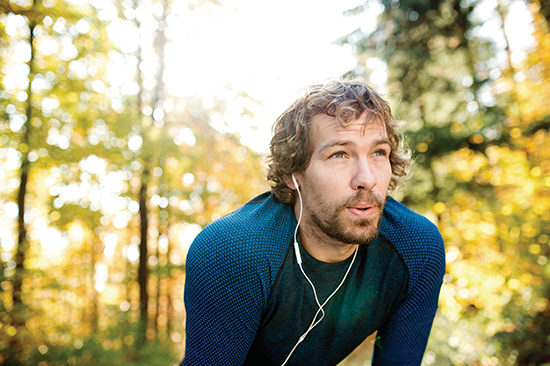HEALTHY LIVING
Spring into wellness

7 tips to promote health and well-being as weather gets warmer
(Family Features) As seasons change, there’s often a great deal of shuffling and movement, including common allergy triggers like trees, pollen, mold spores, dust and dander along with pesky sinus pressure. Combined with changes in barometric pressure and weather patterns bouncing up and down, spring can be one big pain – literally.
“This is the time of year when most of us are excited to see the change of seasons, but millions of allergy and sinus sufferers welcome spring with trepidation,” Dr. Ian Smith, M.D., said. “Common triggers such as trees, pollen, mold spores, dust and dander can wreak havoc for many. Having a trusted multi-symptom reliever of upper respiratory allergies like Mucinex Sinus-Max is absolutely key in making the season more enjoyable for all suffering from sinus and congestion issues. With a reliable multi-symptom product stashed in your medicine cabinet, and the combination of simple modifications like being mindful of your indoor climate, eating more fruits and veggies, and staying hydrated, can help limit sinus discomfort this season.”
Take steps this spring to ease the impact of sinus and allergy problems and focus on your overall wellness for a smooth transition with these tips:
Control your allergy and sinus triggers. Knowing what flares your allergic reactions can help prevent discomfort. For many people, monitoring pollen counts and limiting time outdoors on high-pollen days can help reduce reactions. You might also avoid hanging laundry outside, as pollen can stick to clothes and sheets as they dry, and ask for help with yardwork to limit your exposure.
Find some pressure release. When nasal congestion or sinus pressure build, it can feel like a ton of bricks have landed on your head. However, you can find relief with products designed to help clear up your stuffy nose, relieve headaches and thin and loosen excess mucus. Often, if you’re experiencing sinus problems, you’re dealing with multiple symptoms. From congestion to headaches and sinus pressure, an over-the-counter medicine like Mucinex Sinus-Max can break up your sinus symptoms with just one dose or your money back.
Manage your indoor climate. Even when you start spending more time outdoors, it’s important to keep close tabs on the quality of the air inside your home. If you’re prone to allergy flare-ups or sinus infections, manage the humidity level by using a humidifier or dehumidifier. If outdoor allergens are a concern, avoid opening windows and doors, and instead rely on air conditioning on warmer days. Also be sure to change filters regularly and use an air purifier for added protection.
Pile on fresh produce. After spending cooler months consuming comfort foods and fewer fresh veggies, spring ushers in a new menu of opportunity. Take advantage of all the garden-rich options and fuel your body with vitamin- and nutrient-rich produce that fills farmers markets, grocery stores and even roadside stands.
Soak up the sun (responsibly). After months indoors, you’re probably ready to spend some time soaking up the sun’s rays. Vitamin D is an essential nutrient that affects numerous body systems, including the immune system and bone health. It’s also been shown to improve your mood and reduce depression, so take in plenty of fresh air and sparkling sunlight. Just remember to slather on plenty of sunscreen to protect your skin from harmful UV rays and don’t forget to protect your eyes with UV-blocking sunglasses.
Keep fluids flowing. More time outdoors in warmer weather can quickly lead to dehydration, especially if you’re working up a sweat. Drink plenty of water to stay well hydrated and keep your body operating in top shape. Staying hydrated can also help keep mucus moving, allowing you to ease through allergy or sinus problems.
Update your medicine cabinet. A seasonal change is a good time to take stock of your medical supplies and medications to ensure you have what you need for the months ahead. Discard any expired prescriptions or over the counter medicines and be sure restock common spring and summer essentials like bug bite ointments, sunburn spray and multi-symptom products like Mucinex Sinus-Max to help temporarily relieve sinus and congestion symptoms in one dose. Also be sure to replenish your first aid kit with plenty of bandages and wound care supplies.

Manage Mucus
From maintaining hydration of the respiratory tract to protecting against harmful foreign pathogens, mucus plays an important role in the body. Allergies, smoking or any upper respiratory tract infection, such as the common cold or flu, could trigger excess mucus, causing bothersome symptoms that interfere with your overall well-being. These simple steps from the experts at Mucinex can help minimize these issues.
Humidifiers and vaporizers can help ease mucus symptoms by adding moisture to the air you breathe. By eliminating dry air, which can be irritating to the airways, you’re providing yourself with moist air that may help reduce nasal stuffiness. Vaporizers use heat to create boiling water, which adds steam to the air. Humidifiers release cool mist.
Nasal decongestants, expectorants and antihistamines can go a long way toward managing mucus. Decongestants help reduce swelling of tissues in the nose and sinuses. This, in turn, helps with easing blockages due to mucus. If allergies are causing your flare-up, antihistamines can help by limiting or blocking histamine, which your body produces during allergic reactions, helping with symptoms like sneezing, runny nose, watery eyes and more. Expectorants, such as Guaifenesin, thin mucus, making it easier for your body to get rid of it.
Nasal irrigation can help ease a stuffy nose caused by mucus buildup. Useful options include neti pots, squeeze bottles and syringes. These methods all involve flushing your nostrils with a saline product to help loosen mucus. Make sure you use new or sterile equipment; the use of the same nasal spray container by more than one person may spread infection. Irrigate only occasionally because frequent use can affect the good bacteria in your nose.
For more information, visit Mucinex.com.
Photos courtesy of Getty Images
SOURCE:
Mucinex
HEALTHY LIVING
5 habits to help maintain immune health

(Family Features) Cold and flu season is here. The best way to battle cold and flu season is to prevent coming down with anything at all. While it’s impossible to stay entirely safe from germs, sniffles and coughs, there are a few healthy habits you can incorporate for extra protection this year.
Along with the guidance you receive from your health care provider, consider these dietary and lifestyle recommendations to support your immune system naturally.
Commit to a Healthier Diet: Essential for optimizing your immune system, eating a healthy diet consisting of more foods like fruits, vegetables, nuts, seeds, legumes and whole grains is recommended by experts. These foods contain beneficial plant compounds linked to health benefits in humans. Case in point: fresh grapes.
Natural grape compounds, including antioxidants and other polyphenols, may help protect the health and function of cells. At the most basic level, healthy cells are the foundation of good health.
Making simple swaps such as choosing fresh California grapes instead of processed snacks or adding grapes into favorite recipes for a healthy boost are tasty ways to add these beneficial compounds.
Studies suggest some grape compounds may positively influence immune function, including resveratrol and certain flavonoids. Additional studies show adding heart-healthy grapes to your daily diet can help support brain, colon and skin health. Grapes are also a good source of vitamin K, which may help support lung health. Incorporate the health benefits of grapes into your diet with an easy, convenient recipe like Grape and Brussels Sprout Slaw, perfect for eating on its own or pairing with a favorite protein such as grilled chicken breast.
Prioritize Basic Hygiene: Preventive practices can help you avoid germs, protecting yourself and others at the same time. Frequently wash your hands using soap and water, limit contact with others who may be sick and cover your nose and mouth with a tissue or elbow while coughing or sneezing.
Stay Active: Cold and flu season lines up with brisk temperatures, often making it more difficult to get outside for exercise. Find an activity you enjoy like moderate-intensity walking, jogging, biking or playing an aerobic sport. The “Journal of Sport and Health Science” reports exercise can help improve immune response and reduce inflammation, making it a key way to prepare your body to fight back.
Hydrate, Hydrate, Hydrate: Staying hydrated helps your immune system by keeping the body’s defenses functioning properly. In addition to drinking water, you can increase hydration by eating foods with high water content like grapes, which contain about 82% water.
Manage Stress: You can help control stress – which has a negative impact on overall health and wellness – in a number of ways. Practice deep breathing or meditation, engage in activities and hobbies that bring joy and develop nighttime habits that promote good sleep. If snacking in the evening, choose foods such as grapes that are a natural source of melatonin, a compound which helps regulate sleep cycles. Talk with someone you trust, like a friend, family member or mental health professional, to help relieve stress.
Visit GrapesFromCalifornia.com to find more ways to support your immune health.

Grape and Brussels Sprout Slaw
Servings: 6
- 1 bag (12 ounces) shredded Brussels sprouts
- 2/3 cup finely shredded red cabbage
- 2 cups red Grapes from California, halved lengthwise
- 1/2 cup finely diced red onion
- 3 scallions, trimmed and thinly sliced
- 2 tablespoons rice vinegar
- 1 1/2 tablespoons honey
- 1 teaspoon fresh lemon or lime juice
- 1 teaspoon low-sodium soy sauce
- 2 tablespoons olive oil
- 1 tablespoon toasted (dark) sesame oil
- freshly ground black pepper, to taste
- 3 tablespoons toasted sesame seeds
- In large mixing bowl, combine shredded sprouts, cabbage, grapes, onion and scallions.
- In small bowl, whisk vinegar, honey, lemon or lime juice and soy sauce. Drizzle in olive and sesame oils while whisking. Toss well with slaw mixture. Chill 45 minutes to incorporate flavors. Season with pepper and sprinkle sesame seeds on top.
Nutritional information per serving: 170 calories; 4 g protein; 22 g carbohydrates; 9 g fat (48% calories from fat); 1.5 g saturated fat (8% calories from saturated fat); 0 mg cholesterol; 60 mg sodium; 4 g fiber.
HEALTHY LIVING
How to discuss vaccination with family, friends

(Family Features) During the fall and winter months, respiratory infections such as flu, COVID-19 and RSV can surge. People who are vaccinated lower their risk of getting seriously ill and needing medical care if they get infected. About 70% of adults in the United States said they probably or definitely will get a flu shot, and more than 50% said they probably or definitely will get an updated COVID-19 vaccine. While many people are ready to get this season’s vaccines, others might still have questions.
“It is normal for people to have questions about vaccines,” said Peter Marks, MD, PhD, director of the U.S. Food and Drug Administration’s Center for Biologics Evaluation and Research, which oversees and reviews vaccine clinical trials. “It’s important for everyone to know that all vaccines go through extensive testing before they are approved and that following approval, they are carefully monitored to identify any safety concerns so that they can be addressed quickly. Hundreds of thousands of volunteers have taken part in respiratory vaccine trials. The results tell us that these vaccines are safe and effective in preventing severe disease caused by flu, COVID-19 and RSV.”
Here are some ways to talk about the importance of this season’s vaccines with a family member or friend who is unsure about getting vaccinated.
Hear them out.When talking about vaccination, it’s important to make others feel heard. There are many reasons why people may have questions and concerns about vaccines or even the health care system in general. Listen to their thinking and try not to judge. They want to know their thoughts and feelings matter.
Focus on the facts. Instead of calling out vaccine myths, focus on vaccine truths. Concentrating on myths can cause them to become the topic of your conversation. Instead, speak about the benefits of vaccines. For instance, you can mention vaccines cut your risk of being hospitalized for flu or COVID-19 by about half.
Ask if they need help getting vaccinated. Sometimes, people just need some help to find, schedule and get a vaccination. You can help them find a vaccine location at Vaccines.gov. They may also need help finding child care or figuring out whether they can take time off from work. Offering a ride or accompanying them can also be helpful, especially if the closest vaccination site is far away. If English is not their primary language, offer to help them schedule the appointment and arrange for a medical translator if needed. When it’s easier to get vaccinated, people are more likely to take this important step to help protect their health.
Having open, honest and supportive conversations about vaccines with family members and friends can make all the difference. For more information, visit cdc.gov/RiskLessDoMoreor talk to your doctor.
Flu, COVID-19 and RSV Vaccines Help People Risk Less Severe Illness and Do More of What They Enjoy
This season’s vaccines are now available. Everyone 6 months and older should get an updated flu and COVID-19 vaccine. Everyone ages 75 and older, or 60 and older with certain health conditions such as such as heart disease, lung disease, obesity or diabetes, should get an RSV vaccine if they have not been vaccinated for RSV before.
For certain people, the risk of serious respiratory illness remains high. These include adults ages 65 and older, residents of long-term care facilities, pregnant people, people with certain health conditions and those living in rural areas. People in some racial and ethnic groups, including people who are Black or Hispanic, are also at higher risk. People who are not up to date on flu, COVID-19 and RSV vaccines can reduce their risk by getting their 2024-25 vaccines as soon as they can.
To get started, visit Vaccines.gov.
Photos courtesy of Shutterstock
SOURCE:
United States Department of Health and Human Services
HEALTHY LIVING
Smart starts for a healthy heart

Improve hydration, skip added sugars with better-for-you beverages
(Family Features) How you start your morning can impact the rest of your day. If you’re looking to incorporate healthier choices into your morning routine, try a concept known as “habit stacking.” Building tiny, healthier habits into routines you already have, like enjoying a morning beverage or breakfast before you check your email instead of jumping right into the day’s tasks, can make it easier to stick to a new habit when it’s built into an existing routine.
If you already enjoy the routine of breakfast to start the day, consider swapping sugary drinks for beverages without added sugars like unsweetened green or black tea. When incorporated as part of an overall healthy diet, unsweetened tea can help support heart health.
If you need help getting started, Lipton, a proud national sponsor of the American Heart Association’s Life is Why campaign, created these easy-to-make, better-for-you tea recipes.
A small handful of ingredients makes a big splash in Green Tea Berry Banana Smoothies, ideal for an on-the-go breakfast. For a little refreshment any time of day, simple Sparkling Green Tea Cranberry Spritzers offer a solution with 0 grams of added sugars while non-alcoholic Green Tea Mojito Mocktails provide natural sweetness with 100% fruit juice.
Choosing beverages with no added sugars can contribute to a healthy heart, according to the American Heart Association, making these recipes perfect for daily habit stacking. Water is needed to keep your body running at its best, and because unsweetened tea is 99.5 % water, it provides a delicious way to help hydrate.
Discover more ways to improve daily routines at Heart.org/eatsmart.

Green Tea Berry Banana Smoothies
Recipe courtesy of the American Heart Association
Servings: 4 (1 1/2 cups per serving)
- 3 cups water
- 8 single-serving green tea bags
- 16 ounces frozen mixed berries (about 3 cups)
- 2 medium bananas, peeled, cut in half and frozen
- 1 cup fat-free plain Greek yogurt
- 2 teaspoons fresh-grated peeled gingerroot (optional)
- 2 teaspoons vanilla extract (optional)
- 2 teaspoons chia or flax seeds (optional)
- In small saucepan over high heat, bring water to boil. Remove pan from heat. Submerge tea bags. Steep 4 minutes. Discard tea bags. Let tea mixture cool 30 minutes. Pour into pitcher. Refrigerate 2 hours, or until chilled.
- In food processor or blender, process tea, berries, bananas and yogurt until smooth. Add gingerroot and vanilla, if desired, and process until smooth. Pour into four glasses. Sprinkle with chia seeds, if desired.
Nutritional information per serving (without optional ingredients): 136 calories; 1 g total fat (0 g saturated fat, trans fat, polyunsaturated fat and monounsaturated fat); 3 mg cholesterol; 23 mg sodium; 29 g carbohydrates; 5 g fiber; 18 g total sugars (0 g added sugars); 8 g protein.

Green Tea Mojito Mocktails
Recipe courtesy of the American Heart Association
Servings: 4 (1 1/2 cups per serving)
- 4 cups water
- 4 single-serving green tea bags
- 32-40 sprigs fresh mint, plus additional for garnish, divided
- 2 cups ice cubes
- 1 cup 100% white grape juice
- 1/2 cup fresh lime juice (about 4 medium limes)
- 1 medium lime, cut into four wedges or lime zest twists (optional)
- In small saucepan over high heat, bring water to boil. Remove pan from heat. Submerge tea bags. Steep 4 minutes. Discard tea bags. Let tea mixture cool 30 minutes. Pour into pitcher. Refrigerate 2 hours, or until chilled.
- At serving time, add mint leaves to four glasses. Using muddler or wooden spoon, mash mint leaves several times to release juices. Don’t mash into pulp. Add ice.
- Stir white grape juice and lime juice into tea mixture. Pour into glasses. Garnish each with lime wedge and mint leaf.
Tip: To get more juice from citrus, before slicing, microwave fruit on high 30 seconds, or until warm. When cool enough to handle, use citrus reamer or handheld juice press to juice citrus.
Nutritional information per serving: 45 calories; 0 g total fat (0 g saturated fat, trans fat, polyunsaturated fat and monounsaturated fat); 0 mg cholesterol; 7 mg sodium; 13 g carbohydrates; 0 g fiber; 10 g total sugars (0 g added sugars); 1 g protein.

Sparkling Green Tea Cranberry Spritzers
Recipe courtesy of the American Heart Association
Servings: 4 (1 1/2 cups per serving)
- 4 cups water
- 4 single-serving green tea bags
- 1 cup 100% cranberry juice or 100% cranberry-pomegranate juice
- 2 cups ice cubes
- 1/2 cup seltzer (flavored or plain) or low-sodium club soda, chilled
- 4 orange slices or lime wedges (optional)
- In small saucepan over high heat, bring water to boil. Remove pan from heat. Submerge tea bags. Steep 4 minutes. Discard tea bags. Let tea mixture cool 30 minutes. Pour into pitcher. Stir in cranberry juice. Refrigerate 2 hours, or until chilled.
- At serving time, put ice cubes in four glasses. Pour tea mixture into glasses. Top each serving with seltzer. Garnish with orange slices.
Tip: To create cranberry-flavored ice cubes, fill ice cube tray with 100% cranberry juice and freeze.
Nutritional information per serving: 32 calories: 0 g total fat (0 g saturated fat, trans fat, polyunsaturated fat and monounsaturated fat); 0 mg cholesterol; 4 mg sodium; 8 mg carbohydrates; 0 g fiber; 8 g total sugars (0 g added sugars); 1 g protein.
SOURCE:
American Heart Association
-

 NEWS2 years ago
NEWS2 years ago2 hurt, 1 jailed after shooting incident north of Nocona
-

 NEWS1 year ago
NEWS1 year agoSuspect indicted, jailed in Tia Hutson murder
-

 NEWS2 years ago
NEWS2 years agoSO investigating possible murder/suicide
-

 NEWS2 years ago
NEWS2 years agoWreck takes the life of BHS teen, 16
-

 NEWS1 year ago
NEWS1 year agoMurder unsolved – 1 year later Tia Hutson’s family angry, frustrated with no arrest
-

 NEWS2 years ago
NEWS2 years agoSheriff’s office called out to infant’s death
-

 NEWS2 years ago
NEWS2 years agoBowie Police face three-hour standoff after possible domestic fight
-

 NEWS2 years ago
NEWS2 years agoDriver stopped by a man running into the street, robbed at knifepoint





